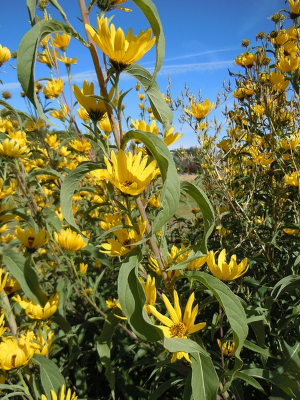Maximilian Sunflower

This spring, I found a plant growing at the edge of my garden, and I decided to leave it to see what it was. Imagine my surprise when I discovered it was a Maximilian Sunflower when it started blooming a couple of weeks ago. This native perennial was named after Prince Maximilian of Germany, a naturalist who led an expedition to the West from 1832 to 1834. This sunflower is a desirable range plant that is commonly eaten by livestock. It also produces a heavy crop of seeds, making it a valuable source of wildlife (which is likely how this plant ended up in my garden). The Maximilian sunflower typically ranges in height from 3-10 feet tall. The leaves are long and narrow, ranging from 2 to 10 inches long. The flower heads are up to 5 inches across and often multiple on a plant. This perennial does form large colonies in its native range. In Kansas, it can commonly be found in dry open areas such as prairies, bald knobs, limestone glades, roadsides, and waste areas. While not widely used in landscaping, this plant works well for sunny borders, wild or native plants, cottage gardens, naturalized areas, and meadows or prairies. It tolerates a wide range of soils, including poor sandy and clay soils, and is very tolerant of drought and dry soils. I’ll transplant this one to a slightly different location and enjoy its beautiful blooms near my garden for years.

Have questions? Contact our office where our Horticulture Extension Agent will assist you with questions.
Phone: (316) 321-9660
Email: callae@ksu.edu